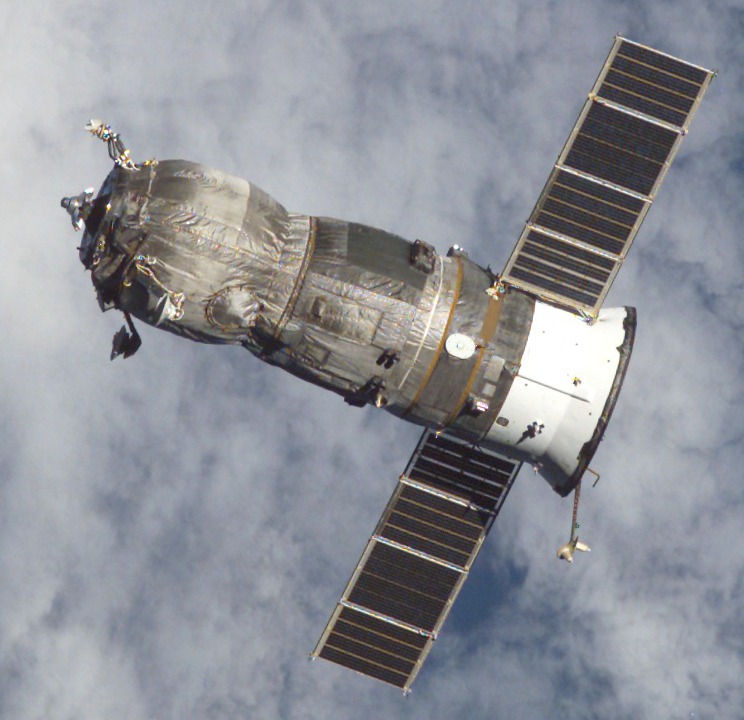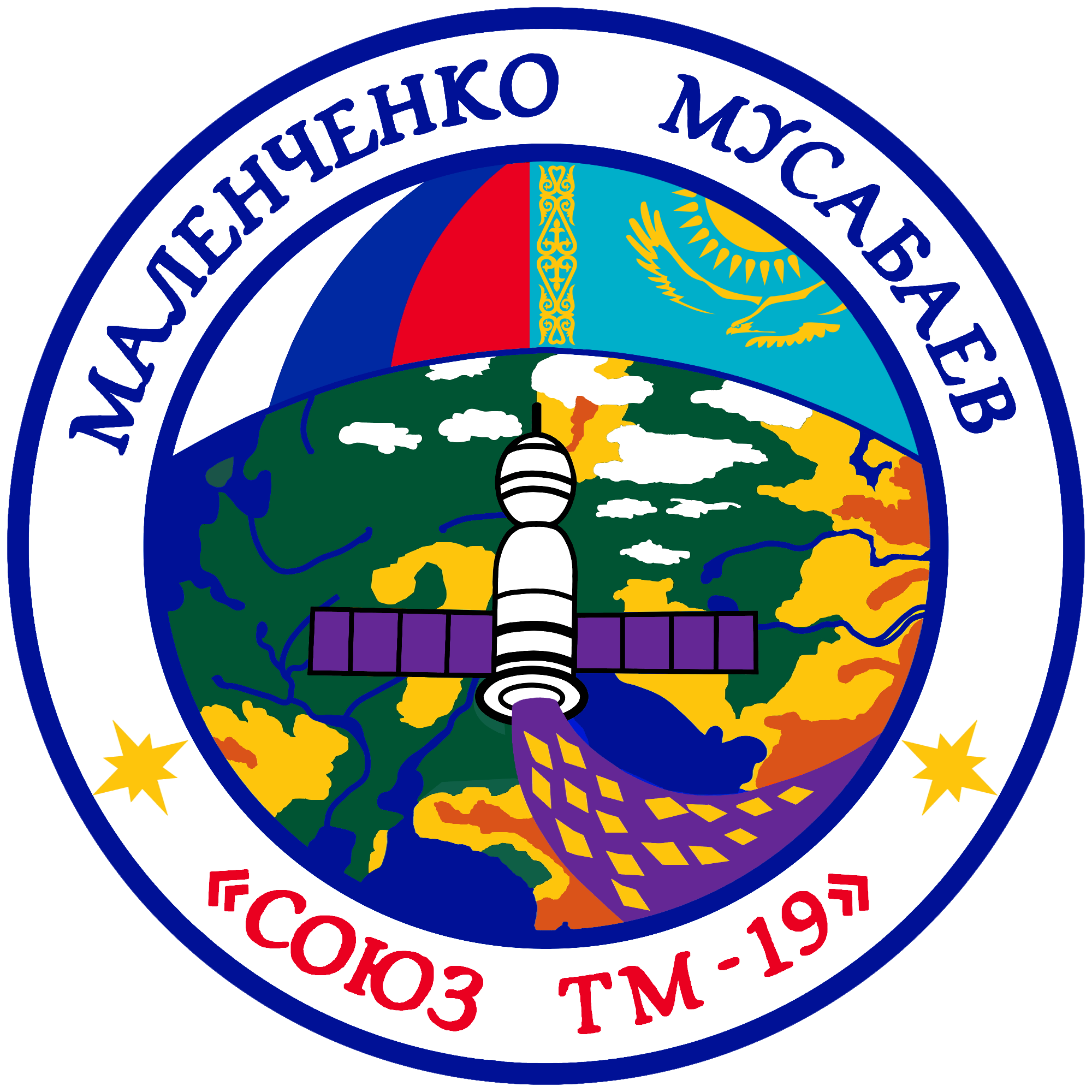|
Progress M-24
Progress M-24 (russian: Прогресс М-24, italic=yes) was a Russian uncrewed cargo spacecraft which was launched in 1994 to resupply the Mir space station; causing minor damage to the station as the result of a collision during a failed attempt to dock. Spacecraft The forty-second of sixty four Progress spacecraft to visit Mir, M-24 used the Progress-M 11F615A55 configuration, and had the serial number 224. It carried supplies including food, water and oxygen for the EO-16 crew aboard Mir, as well as equipment for conducting scientific research, and fuel for adjusting the station's orbit and performing manoeuvres. Amongst its cargo were two new spacesuits, three fire extinguishers, oxygen candles, and equipment to facilitate repairs to Mir's life support system. Flight Progress M-24 was launched at 14:25:12 UTC on 25 August 1994, atop a Soyuz-U carrier rocket flying from Site 1/5 at the Baikonur Cosmodrome. Following two days of free flight, it approached the forward port ... [...More Info...] [...Related Items...] OR: [Wikipedia] [Google] [Baidu] |
Progress-M
Progress-M (russian: Прогресс-М, GRAU indices 11F615A55 and 11F615A60), also known as Progress 7K-TGM, is a Russian, previously Soviet spacecraft which is used to resupply space stations. It is a variant of the Progress spacecraft, originally built in the late 1980s as a modernised version of the Progress 7K-TG spacecraft, using new systems developed for the Soyuz-T and Soyuz-TM spacecraft. The 11F61560 variant incorporated further modernisation, with digital flight control systems replacing the earlier analogue ones. The older 11F615A55 spacecraft outlived the newer 11F615A60. The final Progress-M, Progress-M-UM, was launched on 24 November 2021. The first forty three Progress-M spacecraft were used to resupply Mir, with subsequent spacecraft flying to the International Space Station. , eighty seven spacecraft have been launched, with sixty seven using the older model, and twenty using the newer version. Launches of the 11F615A60 are continuing. One 11F615A60, Pr ... [...More Info...] [...Related Items...] OR: [Wikipedia] [Google] [Baidu] |
Fire Extinguisher
A fire extinguisher is a handheld active fire protection device usually filled with a dry or wet chemical used to extinguish or control small fires, often in emergencies. It is not intended for use on an out-of-control fire, such as one which has reached the ceiling, endangers the user (i.e., no escape route, smoke, explosion hazard, etc.), or otherwise requires the equipment, personnel, resources, and/or expertise of a fire brigade. Typically, a fire extinguisher consists of a hand-held cylindrical pressure vessel containing an agent that can be discharged to extinguish a fire. Fire extinguishers manufactured with non-cylindrical pressure vessels also exist but are less common. There are two main types of fire extinguishers: stored-pressure and cartridge-operated. In stored pressure units, the expellant is stored in the same chamber as the firefighting agent itself. Depending on the agent used, different propellants are used. With dry chemical extinguishers, nitrogen is typical ... [...More Info...] [...Related Items...] OR: [Wikipedia] [Google] [Baidu] |
Spacecraft Launched In 1994
A spacecraft is a vehicle or machine designed to fly in outer space. A type of artificial satellite, spacecraft are used for a variety of purposes, including communications, Earth observation, meteorology, navigation, space colonization, planetary exploration, and transportation of humans and cargo. All spacecraft except single-stage-to-orbit vehicles cannot get into space on their own, and require a launch vehicle (carrier rocket). On a sub-orbital spaceflight, a space vehicle enters space and then returns to the surface without having gained sufficient energy or velocity to make a full Earth orbit. For orbital spaceflights, spacecraft enter closed orbits around the Earth or around other celestial bodies. Spacecraft used for human spaceflight carry people on board as crew or passengers from start or on orbit ( space stations) only, whereas those used for robotic space missions operate either autonomously or telerobotically. Robotic spacecraft used to support scientific ... [...More Info...] [...Related Items...] OR: [Wikipedia] [Google] [Baidu] |
Progress M-34
Progress M-34 (russian: Прогресс М-34, italic=yes) was a Russian uncrewed cargo spacecraft which was launched in 1997 to resupply the Mir space station, and which subsequently collided with Mir during a docking attempt, resulting in significant damage to the space station. Spacecraft The 52nd of 64 Progress spacecraft to visit Mir, it used the Progress-M 11F615A55 configuration, and had the serial number 234. It carried supplies including food, water, and oxygen for the EO-23 crew aboard Mir, as well as equipment for conducting scientific research, and fuel for adjusting the station's orbit and performing maneuvers. Among its cargo were two new spacesuits, three fire extinguishers, oxygen candles, and equipment to facilitate repairs to Mir's life support system. Launch and docking Progress M-34 was launched at 16:04:05 UTC on 6 April 1997, atop a Soyuz-U carrier rocket flying from Site 1/5 at the Baikonur Cosmodrome. Following two days of free flight, it docked with th ... [...More Info...] [...Related Items...] OR: [Wikipedia] [Google] [Baidu] |
List Of Uncrewed Spaceflights To Mir ...
This is a list of uncrewed spaceflights to Mir. Components of the space station are indicated in green. *A. - Time from docking until debris impact in the Pacific Ocean at approximately 05:59 GMT on 23 March 2001. *B. - From time of launch *C. - Remained attached during deorbit of space station on 23 March 2001. *D. - Decayed naturally See also *Mir *List of Progress flights *List of human spaceflights to Mir * List of human spaceflights to the International Space Station *Uncrewed spaceflights to the International Space Station *List of Mir spacewalks References {{Space exploration lists and timelines * Mir, uncrewed spaceflights Uncrewed spacecraft Mir ''Mir'' (russian: Мир, ; ) was a space station that operated in low Earth orbit from 1986 to 2001, operated by the Soviet Union and later by Russia. ''Mir'' was the first modular space station and was assembled in orbit from 1986 to&n ... [...More Info...] [...Related Items...] OR: [Wikipedia] [Google] [Baidu] |
List Of Progress Flights
A ''list'' is any set of items in a row. List or lists may also refer to: People * List (surname) Organizations * List College, an undergraduate division of the Jewish Theological Seminary of America * SC Germania List, German rugby union club Other uses * Angle of list, the leaning to either port or starboard of a ship * List (information), an ordered collection of pieces of information ** List (abstract data type), a method to organize data in computer science * List on Sylt, previously called List, the northernmost village in Germany, on the island of Sylt * ''List'', an alternative term for ''roll'' in flight dynamics * To ''list'' a building, etc., in the UK it means to designate it a listed building that may not be altered without permission * Lists (jousting), the barriers used to designate the tournament area where medieval knights jousted * ''The Book of Lists'', an American series of books with unusual lists See also * The List (other) * Listing ... [...More Info...] [...Related Items...] OR: [Wikipedia] [Google] [Baidu] |
1994 In Spaceflight
This article outlines notable events occurring in 1994 in spaceflight Spaceflight (or space flight) is an application of astronautics to fly spacecraft into or through outer space, either with or without humans on board. Most spaceflight is uncrewed and conducted mainly with spacecraft such as satellites in ..., including major launches and EVAs. Launches , colspan="8", January , - , colspan="8", February , - , colspan="8", March , - , colspan="8", April , - , colspan="8", May , - , colspan="8", June , - , colspan="8", July , - , colspan="8", August , - , colspan="8", September , - , colspan="8", October , - , colspan="8", November , - , colspan="8", December , - Deep Space Rendezvous EVAs References Footnotes {{DE ... [...More Info...] [...Related Items...] OR: [Wikipedia] [Google] [Baidu] |
Pacific Ocean
The Pacific Ocean is the largest and deepest of Earth's five oceanic divisions. It extends from the Arctic Ocean in the north to the Southern Ocean (or, depending on definition, to Antarctica) in the south, and is bounded by the continents of Asia and Oceania in the west and the Americas in the east. At in area (as defined with a southern Antarctic border), this largest division of the World Ocean—and, in turn, the hydrosphere—covers about 46% of Earth's water surface and about 32% of its total surface area, larger than Earth's entire land area combined .Pacific Ocean . '' Britannica Concise.'' 2008: Encyclopædia Britannica, Inc. The centers of both the |
Atmospheric Re-entry
Atmospheric entry is the movement of an object from outer space into and through the gases of an atmosphere of a planet, dwarf planet, or natural satellite. There are two main types of atmospheric entry: ''uncontrolled entry'', such as the entry of astronomical objects, space debris, or bolides; and ''controlled entry'' (or ''reentry'') of a spacecraft capable of being navigated or following a predetermined course. Technologies and procedures allowing the controlled atmospheric ''entry, descent, and landing'' of spacecraft are collectively termed as ''EDL''. Objects entering an atmosphere experience atmospheric drag, which puts mechanical stress on the object, and aerodynamic heating—caused mostly by compression of the air in front of the object, but also by drag. These forces can cause loss of mass (ablation) or even complete disintegration of smaller objects, and objects with lower compressive strength can explode. Crewed space vehicles must be slowed to subsonic speeds be ... [...More Info...] [...Related Items...] OR: [Wikipedia] [Google] [Baidu] |
Yuri Malenchenko
Yuri Ivanovich Malenchenko (russian: Юрий Иванович Маленченко; born December 22, 1961) is a retired Russian cosmonaut. Malenchenko became the first person to marry in space, on 10 August 2003, when he married Ekaterina Dmitrieva, who was in Texas, while he was over New Zealand, on the International Space Station. As of June 2016, Malenchenko ranks second for career time in space due to his time on both Mir and the International Space Station (ISS). He is a former Commander of the International Space Station. Personal life Malenchenko was born in Khrushchev, Kirovohrad Oblast, Ukrainian SSR. He and his wife Ekaterina Dmitrieva have one child. Education Malenchenko graduated from the Kharkiv Military Aviation School in 1983, and attended the Zhukovsky Air Force Engineering Academy, graduating in 1993. Awards Malenchenko was awarded: * Hero of the Russian Federation, * the National Hero of Kazakhstan medal, * Military award of excellence, * Commendation ... [...More Info...] [...Related Items...] OR: [Wikipedia] [Google] [Baidu] |
TORU , village in Kaarma Parish, Saare County, Estonia
{{disambiguation, geo ...
TORU or Toru may refer to: *TORU, spacecraft system *Toru (given name), Japanese male given name *Toru, Pakistan, village in Mardan District of Khyber-Pakhtunkhwa, Pakistan *Tõru Tõru is a village in Saaremaa Parish, Saare County in western Estonia. Before the administrative reform in 2017, the village was in Lääne-Saare Parish Lääne-Saare Parish ( et, Lääne-Saare vald) was a rural municipality of Estonia, in S ... [...More Info...] [...Related Items...] OR: [Wikipedia] [Google] [Baidu] |
Life Support System
A life-support system is the combination of equipment that allows survival in an environment or situation that would not support that life in its absence. It is generally applied to systems supporting human life in situations where the outside environment is hostile, such as outer space or underwater, or medical situations where the health of the person is compromised to the extent that the risk of death would be high without the function of the equipment. In human spaceflight, a life-support system is a group of devices that allow a human being to survive in outer space. US government space agency NASA, and private spaceflight companies use the term environmental control and life-support system or the acronym ECLSS when describing these systems. The life-support system may supply air, water and food. It must also maintain the correct body temperature, an acceptable pressure on the body and deal with the body's waste products. Shielding against harmful external influences suc ... [...More Info...] [...Related Items...] OR: [Wikipedia] [Google] [Baidu] |



.jpg)


